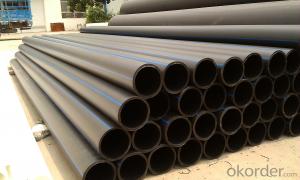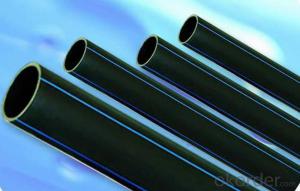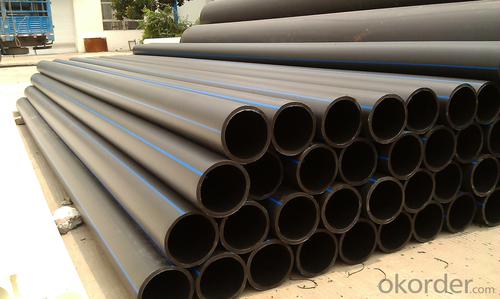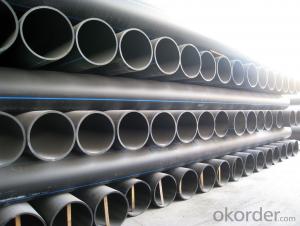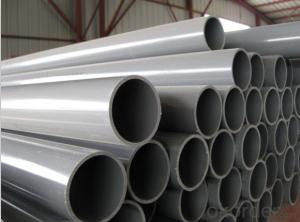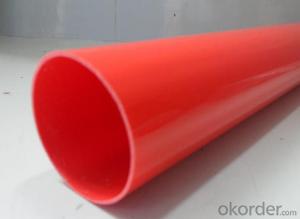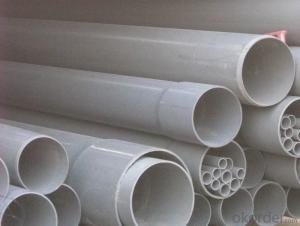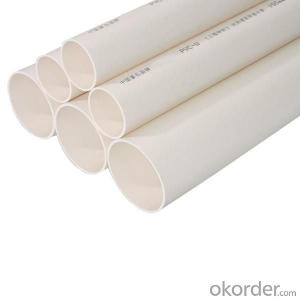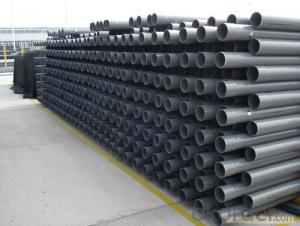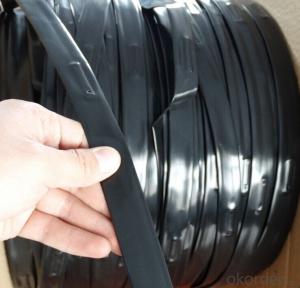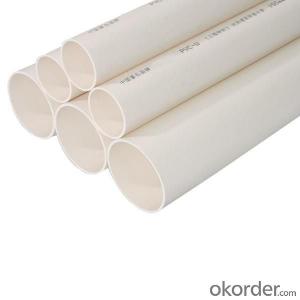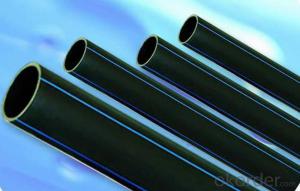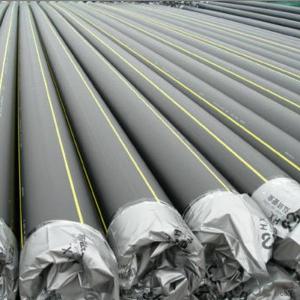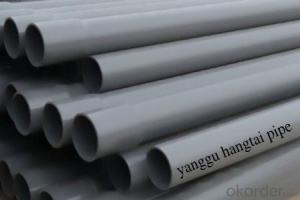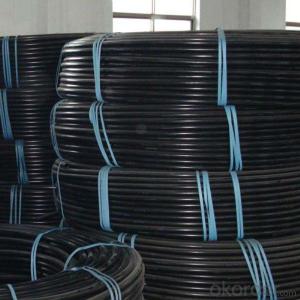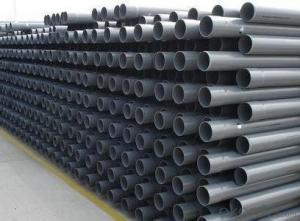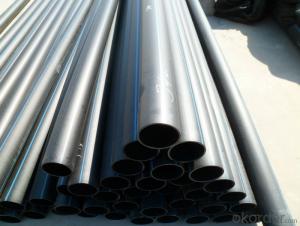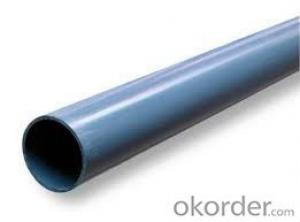Plastic Tubes HDPE Pipe ISO4427-2000 DN125
- Loading Port:
- China Main Port
- Payment Terms:
- TT OR LC
- Min Order Qty:
- -
- Supply Capability:
- -
OKorder Service Pledge
OKorder Financial Service
You Might Also Like
Physical properties[edit]
Polyethylene is a thermoplasticpolymer consisting of long hydrocarbon chains. Depending on the crystallinity and molecular weight, a melting point and glass transition may or may not be observable. The temperature at which these occur varies strongly with the type of polyethylene. For common commercial grades of medium- and high-density polyethylene the melting point is typically in the range 120 to 180 °C (248 to 356 °F). The melting point for average, commercial, low-density polyethylene is typically 105 to 115 °C (221 to 239 °F).it is transprant.
Chemical properties[edit]
Most LDPE, MDPE and HDPE grades have excellent chemical resistance, meaning that it is not attacked by strong acids or strong bases. It is also resistant to gentle oxidants and reducing agents. Polyethylene burns slowly with a blue flame having a yellow tip and gives off an odour of paraffin. The material continues burning on removal of the flame source and produces a drip.[3] Crystalline samples do not dissolve at room temperature. Polyethylene (other than cross-linked polyethylene) usually can be dissolved at elevated temperatures in aromatic hydrocarbons such as toluene or xylene, or in chlorinated solvents such as trichloroethane or trichlorobenzene.[4]
GB/T13663-2000:
| PE63管材规格 | |||||
| 公称 外径dn,mm | SDR33 | SDR26 | SDR17.6 | SDR13.6 | SDR11 |
| 公称压力 PN,Mpa | |||||
| 0.32 | 0.4 | 0.6 | 0.8 | 1.0 | |
| 公称 壁厚 | 公称 壁厚 | 公称 壁厚 | 公称 壁厚 | 公称 壁厚 | |
| 16 | 2.3 | ||||
| 20 | 2.3 | 2.3 | |||
| 25 | 2.3 | 2.3 | 2.3 | ||
| 32 | 2.3 | 2.4 | 2.9 | ||
| 40 | 2.3 | 2.3 | 3.0 | 3.7 | |
| 50 | 2.3 | 2.9 | 3.7 | 4.6 | |
| 63 | 2.3 | 2.5 | 3.6 | 4.7 | 5.8 |
| 75 | 2.3 | 2.9 | 4.3 | 5.6 | 6.8 |
| 90 | 2.8 | 3.5 | 5.1 | 6.7 | 8.2 |
| 110 | 3.4 | 4.2 | 6.3 | 8.1 | 10.0 |
| 125 | 3.9 | 4.8 | 7.1 | 9.2 | 11.4 |
| 140 | 4.3 | 5.4 | 8.0 | 10.3 | 12.7 |
| 160 | 4.9 | 6.2 | 9.1 | 11.8 | 14.6 |
| 180 | 5.5 | 6.9 | 10.2 | 13.3 | 16.4 |
| 200 | 6.2 | 7.7 | 11.4 | 14.7 | 18.2 |
| 225 | 6.9 | 8.6 | 12.8 | 16.6 | 20.5 |
| 250 | 7.7 | 9.6 | 14.2 | 18.4 | 22.7 |
| 280 | 8.6 | 10.7 | 15.9 | 20.6 | 25.4 |
| 315 | 9.7 | 12.1 | 17.9 | 23.2 | 28.6 |
| 355 | 10.9 | 13.6 | 20.1 | 26.1 | 32.2 |
| 400 | 12.3 | 15.3 | 22.7 | 29.4 | 36.3 |
| 450 | 13.8 | 17.2 | 25.5 | 33.1 | 40.9 |
| 500 | 15.3 | 19.1 | 28.3 | 36.8 | 45.4 |
| 560 | 17.2 | 21.4 | 31.7 | 41.2 | 50.8 |
| 630 | 19.3 | 24.1 | 35.7 | 46.3 | 57.2 |
- Q: Can plastic tubes be used for roller coasters?
- Plastic tubes can potentially be used for roller coasters, specifically in the construction of track components such as supports, guide rails, or even the coaster cars themselves. However, the feasibility and safety of using plastic tubes would greatly depend on various factors such as the specific type and quality of plastic used, engineering requirements, load-bearing capacity, and overall design considerations.
- Q: Why do all squeeze tubes have a square at the top?
- Do you mean at the portion furthest from the opening with the cap? Because the tube is filled from the end that is furthest from the opening with cap. Years ago (before flexible plastics existed) all tubes were made from a thick aluminum foil, the cap was put on it, the tube was filled from the opposite end from the cap, and the tube was sealed after filling by folding the open end over a few times and crimping it, which always produced a square end. Now adays with plastic tubing, which is sealed by melting the tube end together you could make it have pretty much any shape, but due to tradition a square end is still used, because that is what customers are used to buying.
- Q: Why fire water pipes do not use PVC plastic pipes?
- Because of the lower level of safety guarantee, the water for domestic use can be maintained without water at any time. Therefore, fire pipe network requires steel pipe instead of PVC pipe.
- Q: Can plastic tubes be reused?
- Yes, plastic tubes can be reused depending on their condition and purpose. If they are clean and undamaged, they can be washed and used again for various applications such as packaging, storage, or transportation. However, it is important to consider the type of plastic and any specific regulations or guidelines for reuse to ensure safety and effectiveness.
- Q: Have an 01 Nissan Sentra and the dipstick handle broke of and while trying to get the dipstick out it got pushed in about 3-4 inches. How do we get it out? Is it safe to move the vehicle while its in there? Please help thank you.
- Unbolt the dip stick tube and you'll be able to push it up and out from the bottom of the tube. It's a fairly common problem with the dip sticks that have a plastic top. Over time due to the heat their exposed to they become brittle and the plastic ring snaps off. A magnet won't work because the top is plastic. The tube is usually held in with a 10 or 12mm bolt. Yes it's safe to move it. Good luck and hope this helps.
- Q: How do you prevent plastic tubes from warping in direct sunlight?
- One way to prevent plastic tubes from warping in direct sunlight is to use UV-resistant or weather-resistant plastic materials. These types of plastics are specifically designed to withstand prolonged exposure to sunlight without warping or deforming. Additionally, you can also apply a protective coating or paint with UV inhibitors to the surface of the tubes, which can provide an extra layer of protection.
- Q: Can plastic tubes be used for packaging food products?
- Yes, plastic tubes can be used for packaging food products.
- Q: What are the different closure options for twist-off tubes?
- The different closure options for twist-off tubes include screw caps, flip-top caps, snap-on caps, and press-on caps.
- Q: Are plastic tubes suitable for personal care product packaging?
- Yes, plastic tubes are suitable for personal care product packaging. They are lightweight, durable, and can be easily squeezed to dispense the product. Additionally, plastic tubes offer excellent barrier properties, protecting the product from moisture, air, and contaminants. They are also cost-effective and allow for easy customization and branding opportunities.
- Q: How do plastic tubes compare to Teflon tubes in terms of chemical resistance?
- Plastic tubes generally have good chemical resistance, but Teflon tubes are known for their superior chemical resistance properties. Teflon tubes can withstand a wider range of chemicals, including highly corrosive substances, making them more suitable for applications requiring high chemical resistance.
Send your message to us
Plastic Tubes HDPE Pipe ISO4427-2000 DN125
- Loading Port:
- China Main Port
- Payment Terms:
- TT OR LC
- Min Order Qty:
- -
- Supply Capability:
- -
OKorder Service Pledge
OKorder Financial Service
Similar products
Hot products
Hot Searches
Related keywords
